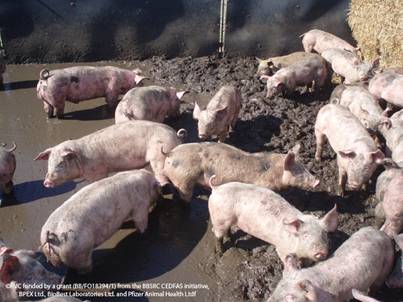Transmission
Infected animals shed the virus in saliva, nasal secretions, aerosol, urine, semen, milk and faeces. Saliva is a particularly important source of the virus because it survives well in the pig's tonsils. Transfer of the virus can easily occur through saliva when mixing pigs at any production stage.
Once the virus is eliminated by the pigs, it still can survive in the environment. The survival time depends on temperature, pH and exposure to detergents. For example, at 20°C the virus survives on average for 27 hours (between 17 and 38 hours); while at 4°C the virus can survive up to 180 hours. However, in water and pig slurry lagoons the survival time increases to 8-11 days. PRRS virus remains stable in a pH between 6.5 and 7.5 and is considered unstable and quickly inactivated in extreme pHs and by drying. So if during that time, new pigs arrive on the farm, they can become infected.

PRRS virus survives longer in pig slurry
Transmission of the virus can occur by various means:
- Direct contact: which can be by nose to nose transmission or by infected semen
- Vertical transmission: from infected sows to foetus (PRRSV can cross the placenta during mid to late gestation and infect foetuses)
- Mechanical infection (indirect route): numerous indirect transmission routes have been identified; the main ones being contaminated boots, overalls, transport vehicles and infected needles. Insects may carry the virus from infected to naive pigs (up to a distance of 21/2 km). Similarly, transmission by aerosol can occur over 120 m.
The good news is that mechanical infection can be easily avoided, by improving (or implementing) biosecurity measures, good hygiene and modifying some management practices. We will come back to this in the unit on "Alternative strategies for managing PRRS and PMWS"
Considering what we have covered so far about PRRS, list the potential predisposing factors for the disease?
Check next section and see if it is similar to what you thought